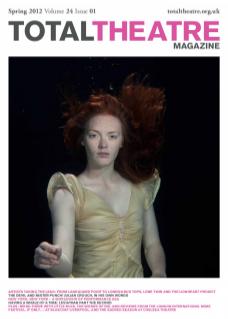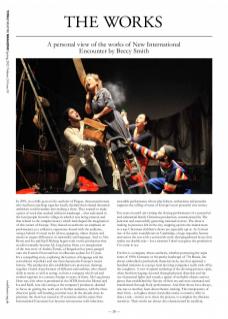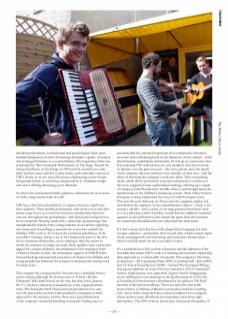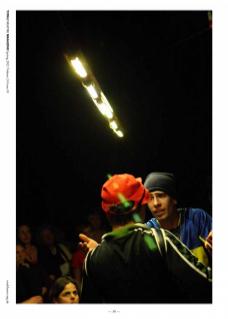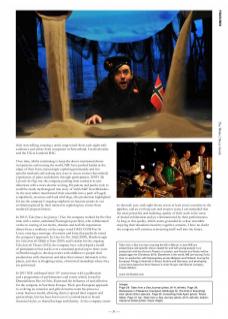In 2001, in a chilly gym on the outskirts of Prague, three practitioners who had been teaching together locally decided their shared theatrical ambitions could translate into making a show. They wanted to make a piece of work that worked within its landscape – that welcomed in the local people from the village in which it was being created, and that related to the complex history which had shaped the imagination of this corner of Europe. They shared an aesthetic: an emphasis on performance as a collective experience shared with the audience, using a hybrid of visual styles (clown, puppetry, object theatre and music) to negate differences in nationality and language. And so Alex Byrne and Iva and Kjell Moberg began work on the production that would eventually become My Long Journey Home, a re-imagination of the true story of András Tamás, a Hungarian boy press-ganged onto the Eastern Front and lost in a Russian asylum for 53 years. It’s a compelling story, exploring the barriers of language and the convulsions of politics and war that characterise Europe’s recent history. The production also established core processes: drawing together a band of performers of different nationalities, who shared skills in music as well as acting, to form a company who lived and worked together in a country foreign to many of them. My Long Journey Home was a hit when it premiered at the MTM festival in Mostar and Iva and Kjell, now also acting as the company’s producers, decided to focus on getting the work out to further audiences, with the three directors partly self-funding an initial tour. In the decade since its premiere the show has toured to 23 countries and the name New International Encounter has become synonymous with infectious ensemble performance whose playfulness, enthusiasm and panache supports the telling of some of Europe’s most powerful true stories.
Ten years on and I am visiting the closing performance of a successful and substantial family Christmas production, commissioned by The Junction and successfully garnering national reviews. The show is making its presence felt in the city, stepping up into the mainstream in a way Christmas children’s shows are especially apt at. As I circuit one of the main roundabouts in Cambridge, a huge tarpaulin banner announces the run with a cartoonish snow-clad gingerbread house that makes me double-take – for a moment I don’t recognise the production I’ve come to see.
For this is a company whose aesthetic, whether portraying the sepia tones of 1930s Germany or the punky landscape of ‘70s Russia, has always embodied a particularly theatrical style, one that spawned a hundred imitators as young visual devising companies really took off in the noughties. A sort of spatial rendering of the devising process: open, often freeform staging, focused through physical direction and the use of practical lights and sound; a jigsaw of workable objects and set pieces that established the flavour of their era and were animated and transformed through lively performance. And their shows have always, one way or another, been about theatre-making. The transparency of their form – as hapless clown storytellers make a tentative offer to share a tale – invites us to share the process, to complete the illusions ourselves. Their works are always also characterised by excellent, detailed performances, both physical and psychological. Such openhanded transparency in their dramaturgy demands a quality of musical and acting performance as a counterbalance (My Long Journey Home was nominated for ‘Best Ensemble Performance’ in The Stage Awards for Acting Excellence on the Fringe in 2004 and the awards have come thick and fast since) and this is what strikes such enjoyable contrast in NIE’s shows, as we are moved between collaborating on the theatre being made before us and being transported by it. Academics might call such a shifting dramaturgy post-dramatic.
So what will a mainstream family audience, seduced by the neon tones of sticky, stripy candy make of it all?
NIE have often been described as a company that cast a spell over their audience. Their humble performance style invites us in and their clown-esque focus on us and our reactions continuously checks its own use throughout the performance. And Hansel and Gretel proves to be no exception. Starting small, with a silent line-up downstage that metaphorically beckons their young audience closer before exploding into music and storytelling, it reminds me of just how suitable for children NIE’s style is. It’s not just the exuberant playfulness of the ensemble’s intimacy, always a joy to feel temporarily part of, but also the no-nonsense theatricality, never seeking to hide the means by which the moments of magic are made. Both qualities have a particular appeal for younger audiences unconditioned to the unspoken ‘rules’ of illusory theatre. In fact, the enthusiastic support of ASSITEJ (the forward-looking international association of theatres for children and young people) has bolstered the company’s international touring work for many years.
The company have transposed the fairytale into a decidedly festive, wintry setting (although the closing cries of ‘It feels a bit like Christmas!’ felt a little forced on my visit, but then it was January the 3rd), but have otherwise remained true to the original Grimm story. This being the third Hansel and Gretel production I’ve seen over the past twelve months I feel qualified to comment on their approach to the narrative and the show was a great illustration of the company’s masterful handling of material: finding ways to accommodate the awkward repetitions that underpin the fairytale’s structure and confronting head-on the bleakness of the content – child abandonment, cannibalism and murder, all tied up in a cautionary bow. Encountering NIE without the core cast members who have become so familiar over the past ten years – who have grown up in the family of the company and now settled to have families of their own – had the effect of throwing the company’s work into relief. Their storytelling mode, which allows performers to position themselves in relation to the story, supported some sophisticated readings, offering up a couple of critiques of the Woodcutter’s terrible choices, and brought home the ramifications of the children’s murderous actions. Their folksy Eastern European scoring emphasised the story’s Central European roots. This was the most elaborate set I have seen the company employ, but nevertheless the emphasis on key transformative objects – a bed, a tree stump, a ukelele – and a variety of on-stage powered mechanics such as a very pleasing system of pulleys, meant that the emphasis remained squarely on the performers, who owned the space from the moment we crossed the threshold and were welcomed into their home.
If I don’t always feel they have fully adapted their language for their younger audience – particularly their textual style, which remains rapid, ironic and peppered with interesting and sometimes abstract ideas – there’s certainly much for me as an adult to enjoy.
It’s a combination of this stylistic robustness and the tightness of the ensemble that makes NIE’s work so enduring and resonant, supporting their approach to a real breadth of material. The company’s first three productions – My Long Journey Home (2001), Everything Falls Apart (2002) and The End of Everything Ever (2004) – formed The European Trilogy, sharing an emphasis on some of the key narratives of that Continent’s history: displacement, war, separation (Agata’s fateful disappearing act by nibbling her own nametag on the kindertransport in The End of Everything Ever has become a shorthand for the glorious ‘Oh Fuck’ moment in devised storytelling). These are epic tales that reach across history (a lifetime of Russia’s recent past is held in Everything Falls Apart). Such sweep feels like a natural emphasis for a company whose creative team effortlessly accommodates more than eight nationalities. The 2006-8 show, Instant Epic, showcased this quality of their storytelling, creating a newly improvised show each night with audiences and artists from companies in Switzerland, Czechoslovakia and the UK at London’s BAC.
Over time, whilst continuing to keep the above-mentioned shows in repertoire and touring the world, NIE have pushed harder at the edges of their form, increasingly exploring promenade and site-specific methods and seeking new ways to access stories that embody experiences of place and identity through participation. 2009’s My Life with the Dogs saw the company pushing their aesthetic in new directions with a more electric scoring, 80s palette and punky style to retell the much mythologised true story of ‘wild child’ Ivan Mishukov. As the storytellers transformed their ensemble into a pack of hugely sympathetic, ravenous and loyal wild dogs, this production highlighted for me the company’s ongoing emphasis on fracture-points in our civilisation placed by their interest in exploring key stories from modern European history.
In 2011’s Tales from a Sea Journey / Hav, the company worked for the first time with a writer, acclaimed Norwegian poet Sjón, who collaborated on the re-casting of sea myths, shanties and real life experiences drawn from a residency on the cargo vessel GMA-CGM Fort St Louis, creating a marriage of content and form that perfectly suited the company’s approach. In Linz for Das Schiff (2009), Peterborough for Tales from the Middle of Town (2010) and London for the ongoing Tales from the Thames (2012), the company have a developed a model of participation that works over a sustained period (up to three years in Peterborough) to develop stories with children to people their productions with characters and ideas that connect intimately to the places, and sites (a shopping centre, a historical steamship) where they are performed.
In 2011 NIE celebrated their 10th anniversary with a publication and a programme of performances and events which, hosted by Dramatikkens Hus in Oslo, illustrated the influence of and affection for the company in Northern Europe. Their pan-European approach to evolving an extensive and gifted creative team has proven a canny business model, allowing them to spread their support and partnerships, but has been born out of a commitment to broad theatrical styles, to shared heritage and identity. As the company enters its eleventh year, with eight shows across at least seven countries in the pipeline, and an evolving cast and creative team, I am reminded that the most powerful, and enduring, quality of their work is the sense of shared exhilaration and joy communicated by their performances. As long as this quality, which seems grounded in a close ensemble enjoying their abundant creativity together, remains, I have no doubt the company will continue reinventing itself well into the future.
Tales from a Sea Journey is touring the UK in March, in June NIE are presenting a site-specific show created for and with young people in coproduction with the Unicorn Theatre in London, and Hansel and Gretel will be played again for Christmas 2012. Elsewhere in the world, NIE are touring Twist, their co-production with Kopergietery across Belgium and Holland; touring the European Trilogy to festivals in Korea, Austria and Germany; and developing a new show based on Knut Hamsun’s novel Hunger with Danish company Theater Mollen. www.nie-theatre.com
